If you’re visiting Dubai for a long stopover or business trip, make sure to leave a little space in your bag for a bathing suit, flip-flops and souvenirs.
For business travelers with just a few hours or half-day to spare in the emirate, head to the Dubai Mall. There, pick up a cold drink or frozen yogurt, and head outside to watch one of the world’s most beautiful dancing fountains and be mesmerized by base views of the world’s tallest tower, the Burj Khalifa.
If you feel like getting some exercise in, skip the hotel gym and head out for a run or brisk walk by Kite Beach, where a safe 5km track runs along the coast. Don’t forget to stop and take a selfie on the beach with the sea and Dubai’s iconic sail-shaped Burj al-Arab hotel behind you.
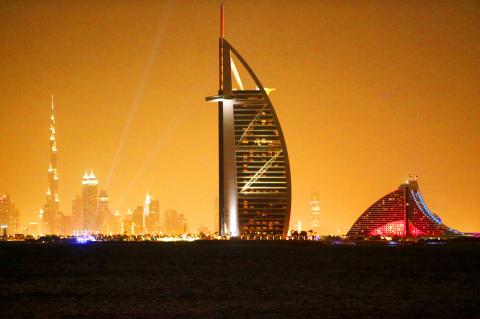
Photo: Reuters
For spinning enthusiasts, head to Fly Dubai where there’s no membership cost. Just call ahead to book a bike at one of Fly Dubai’s two locations for indoor spinning classes, but make sure to order a taxi ahead of time if you go during peak rush hours. The metro does not connect to either location and taxis are hard to find between 4pm and 8pm.
For a quieter afternoon, head to Dubai’s man-made island, The Palm. Go for a day pass at the Atlantis or the Jumeira Zabeel Saray hotel. A day pass during the workweek, which in the Middle East runs from Sunday to Thursday, is significantly cheaper and the beach quieter than the weekend days of Friday and Saturday. Most hotels that offer day passes also include lunch.
FINDING SERENITY
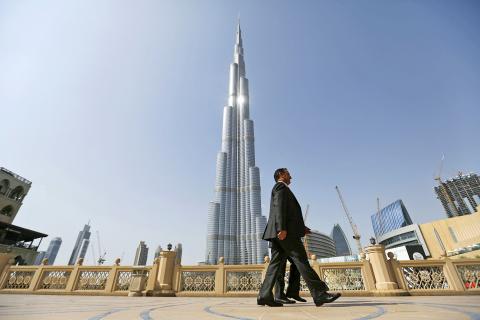
Photo: Bloomberg
If what you need is a few, short hours of complete serenity to clear your head, go for the ultimate pampering experience and head to the spa at the One and Only Royal Mirage across from Dubai Media City or the Talise Spa in Madinat Jumeirah.
Once at Madinat Jumeirah, shop in its famous souq where you can pick up some reasonably priced souvenirs like postcards and Middle Eastern-inspired printed artworks at Gallery One.
Unlike most Middle Eastern markets, this souq is indoors and there isn’t too much haggling over prices. The upside is that what the market misses in authentic folkloric experience it makes up for in air-conditioned comfort between the hot months of April and October.
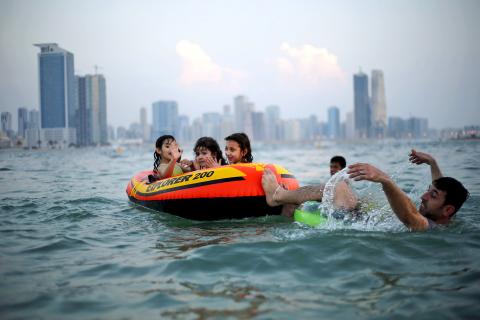
Photo: Reuters
Also at the souq are some of Dubai’s most popular restaurants with views of the Burj al-Arab and a man-made waterway that connects the three hotels that comprise Madinat Jumeirah.
If you are in Dubai between November and March, when the weather is great outdoors, visit The Walk at Jumeirah Beach Residence, better known as JBR. There, visitors can soak up some sun on the beach, enjoy a lavish meal and shop for unique finds at boutiques like Sauce — a homegrown chain of edgy concept stores in Dubai.
The hotels along The Walk are home to some of Dubai’s best restaurants, but meals there don’t come cheap. For something a little less formal, enjoy a bite to eat at one of JBR’s many outdoor cafes and restaurants. At night on the weekends, JBR turns into a bustling street for people watching. The Gulf’s wealthy cruise along the strip in their Ferraris, Lamborghinis, Rolls-Royces and Bentleys.
Nearby are some of the world’s most architecturally stunning skyscrapers in Marina. There, too. you’ll find a mall, outdoor cafes and some of the city’s most expensive real estate overlooking the yachts.

A vaccine to fight dementia? It turns out there may already be one — shots that prevent painful shingles also appear to protect aging brains. A new study found shingles vaccination cut older adults’ risk of developing dementia over the next seven years by 20 percent. The research, published Wednesday in the journal Nature, is part of growing understanding about how many factors influence brain health as we age — and what we can do about it. “It’s a very robust finding,” said lead researcher Pascal Geldsetzer of Stanford University. And “women seem to benefit more,” important as they’re at higher risk of
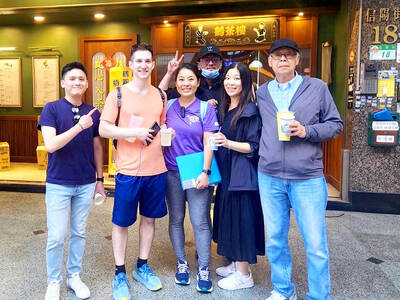
Eric Finkelstein is a world record junkie. The American’s Guinness World Records include the largest flag mosaic made from table tennis balls, the longest table tennis serve and eating at the most Michelin-starred restaurants in 24 hours in New York. Many would probably share the opinion of Finkelstein’s sister when talking about his records: “You’re a lunatic.” But that’s not stopping him from his next big feat, and this time he is teaming up with his wife, Taiwanese native Jackie Cheng (鄭佳祺): visit and purchase a
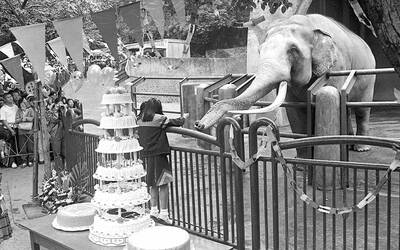
April 7 to April 13 After spending over two years with the Republic of China (ROC) Army, A-Mei (阿美) boarded a ship in April 1947 bound for Taiwan. But instead of walking on board with his comrades, his roughly 5-tonne body was lifted using a cargo net. He wasn’t the only elephant; A-Lan (阿蘭) and A-Pei (阿沛) were also on board. The trio had been through hell since they’d been captured by the Japanese Army in Myanmar to transport supplies during World War II. The pachyderms were seized by the ROC New 1st Army’s 30th Division in January 1945, serving

Mother Nature gives and Mother Nature takes away. When it comes to scenic beauty, Hualien was dealt a winning hand. But one year ago today, a 7.2-magnitude earthquake wrecked the county’s number-one tourist attraction, Taroko Gorge in Taroko National Park. Then, in the second half of last year, two typhoons inflicted further damage and disruption. Not surprisingly, for Hualien’s tourist-focused businesses, the twelve months since the earthquake have been more than dismal. Among those who experienced a precipitous drop in customer count are Sofia Chiu (邱心怡) and Monica Lin (林宸伶), co-founders of Karenko Kitchen, which they describe as a space where they